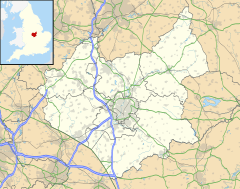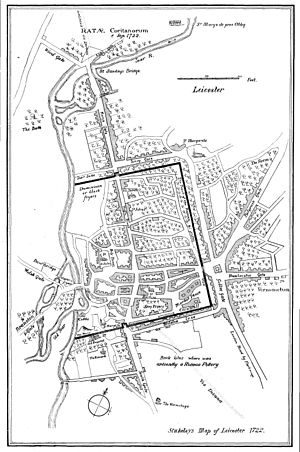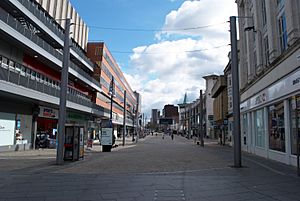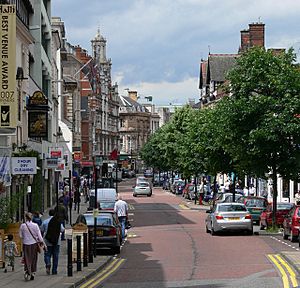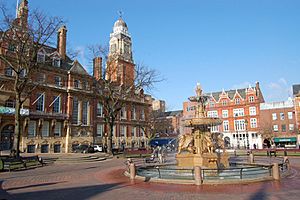Leicester City Centre facts for kids
Quick facts for kids Leicester City Centre |
|
|---|---|
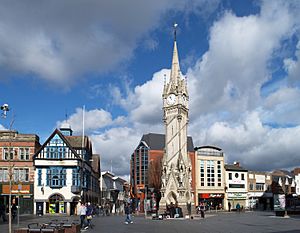 The Haymarket Memorial Clock Tower is the point at which many of central Leicester's main thoroughfares converge |
|
| OS grid reference | SK584044 |
| Unitary authority | |
| Ceremonial county | |
| Region | |
| Country | England |
| Sovereign state | United Kingdom |
| Post town | LEICESTER |
| Postcode district | LE1, LE2 |
| Dialling code | 0116 |
| Police | Leicestershire |
| Fire | Leicestershire |
| Ambulance | East Midlands |
| EU Parliament | East Midlands |
The Leicester City Centre is the heart of Leicester. It's where history, shopping, and transport all come together. This area is mostly surrounded by the A594, which is Leicester's inner ring road.
Many important places are near the city centre. These include the University of Leicester, De Montfort University, and Leicester College. Also close by are the Leicester Royal Infirmary hospital, the Leicester Tigers rugby stadium, and the Leicester City Football Club's King Power Stadium. The famous Golden Mile is to the north.
The city centre has most of Leicester's shops. You can find the Highcross and Haymarket Shopping Centre here. The 'Old Town' is also part of the centre, with Leicester Cathedral and Leicester Market. The city centre has been improved with a £19 million project. This work won several awards for making the area better for people.
Contents
Discovering Leicester's Past
The Old City: Roman Times to Medieval Walls
The historic city of Leicester was first built by the Romans. They called it Ratae Corieltauvorum. It was named after the Corieltauvi, a local British tribe. The city was built where the Fosse Way road crossed the River Soar.
The old Roman walls and gates were likely in the same spots as the later medieval ones. The Roman market, called a forum, was where the modern inner ring road meets St Nicholas Circle. You can still see the Roman baths at Jewry Wall.
The city had four main gates. The east gate was at the end of High Street. The north gate was at the end of Highcross Street. The west gate was near West Bridge. The south gate was in the Friar Lane area. The city walls followed streets like Millstone Lane and Gallowtree Gate.
The old city centre was at the High Cross. This was where High Street and Highcross Street met. Leicester Cathedral and the Guildhall are in this historic part of town.
Leicester Castle was in the south-western corner of the walls. The Newarke was a separate walled area nearby. The Newarke Gateway, now called the Magazine, is the only medieval gate still standing. A small piece of the old town wall can be seen at St Mary de Castro church. The main city gates were taken down in the late 1700s. They were removed to help traffic move more easily.
Modern Changes: New Focus, New Buildings
As Leicester grew, especially in the 1800s, the city's main focus moved east. The Haymarket Memorial Clock Tower became a very important spot. It's where five major roads meet. This change happened because the London Road was better for vehicles than the older Welford Road.
The city's government also moved south. The Corporation of Leicester moved to a new town hall in 1876. This new building was in the Market Street area. It faced a new Town Hall Square, just outside the old walled town.
Between these areas is the modern market. It has a large outdoor covered Leicester Market. There's also an indoor market building for fish, dairy, and meat. Many parts of this old area are now protected as conservation areas.
Outside the ring road, but still close, are De Montfort University and the Leicester Royal Infirmary. You'll also find the Leicester City Football Club's King Power Stadium and the Leicester Tigers' Welford Road stadium. Leicester railway station is just outside the ring road. The University of Leicester is a bit further away. It's connected by the pedestrian-only path called New Walk. This path was made in 1785. It used to go through open fields to the racecourse, which is now Victoria Park.
The area inside the ring road has two big shopping malls. These are Highcross Leicester and the Haymarket Shopping Centre. Both face the Haymarket Memorial Clock Tower area. Highcross first opened as The Shires in 1991. It had a big extension added in 2008. The Haymarket Shopping Centre opened in 1974.
You can find major chain stores on Gallowtree Gate. This street is for pedestrians only. It runs south-east from the clock tower. It then continues as Granby Street towards the railway station. South of Highcross and west of Gallowtree Gate is an area called The Lanes. This area has many small, independent shops. Its main part is the St Martin's Square development. It also has smaller shopping arcades like the Odeon Arcade and the Royal Arcade.
Further south are the market and the civic centre. The civic centre has the main libraries and more shops. The area around Humberstone Gate and the ring-road has two strip malls. One is called 'St George's Retail Park'.
Getting Around Leicester City Centre
The city centre is served by many bus companies. These include Arriva Midlands and First Leicester. There are two main bus stations. St Margaret's Bus Station is to the north of the centre. Haymarket Bus Station is on Charles Street. Some bus services also stop on streets within the city.
Long-distance coaches leave from St Margaret's Bus Station. This station opened in 1985 and was updated in 2007. Haymarket bus station was built in 1994. It was upgraded and expanded in 2014, reopening in 2016. In 2019, work began on a new road. This road will connect the two bus stations. It will also make the area around the clock tower better for walking.
Leicester London Road is the only train station in the city centre now. Two other stations, Leicester Belgrave Road and Leicester Central, closed in the 1960s.
There are over 8,500 car parking spaces in the city centre. There are also 1,500 park and ride spaces. These are at special hubs around the city.
Leicester City Centre Today
Fun Places and Green Spaces
Leicester has many theatres. These include the Y Theatre, the Curve, and the Little Theatre. There's also a small pub theatre called "The Theatre Upstairs."
For movies and art, there's the Phoenix Square Digital Arts Centre. It shows art-house and world cinema films. Highcross Leicester has a Cinema De Lux. There's also an Odeon cinema further south. The old Odeon building is now the Leicester Athena. It's used for conferences and events. The old ABC Cinema building was taken down. It will become a new shopping area with shops, a casino, and a theatre.
The city centre does not have a public swimming pool anymore. The new one, the Braunstone Leisure Centre, is a few miles away.
Most of the area inside the ring-road is built up. But there are some open spaces. These include Nelson Mandela Park, Museum Square, and Town Hall Square. Outside the ring road, you can find Castle Gardens and Victoria Park.
For music, there are places like The Musician, Firebug, and The Shed. Larger venues like De Montfort Hall are a bit further from the city centre.
Several old Anglican churches are in the city centre. St Martin's is now Leicester Cathedral. Other historic churches include St Margaret's and St Nicholas'. St George's Church is now a Serbian Orthodox Church. There is also a large Roman Catholic church called Holy Cross.
The city centre has many CCTV cameras for safety. The main police station is now in Mansfield House.
Making Leicester Better: Regeneration Projects
Highcross Leicester opened in 2008. It has big stores like John Lewis, a cinema, and apartments. It also has two public squares and outdoor dining. Highcross was the start of many new projects in Leicester.
East of Charles Street, there used to be many old factories and warehouses. These are now being turned into homes. This area is called 'St George's' by the council. It became a protected conservation area in 1989.
St George's South is Leicester's new cultural quarter. It has the Leicester Creative Business Depot. This building used to be a bus depot. It helps creative businesses grow. The Leicester Athena is also in this area.
A new £60 million Curve Theatre, Leicester was built opposite the Athena. It opened in 2008. This theatre was designed by Rafael Vinoly Architects. It was built on land that had been empty for a long time.
South of St George's, there are plans for a new business area. This area will be near the train station. It includes using the old police station and updating the Leicester Mercury building.
St George's North is planned to be a new community with homes. Work has also started on properties along the river. There are plans to use the old Great Central station site.
After High Street became pedestrian-only, many small shops moved to this new area. However, some shops have closed due to the economy and the opening of Highcross. There are plans to create a new pedestrian square.
Leicester's Buildings and Landmarks
Important and Historic Buildings
Leicester has several Grade I listed buildings. These are very important historic buildings.
- Jewry Wall
- Castle, Turret Gateway, Castle Hall, and St Mary de Castro church
- The Guildhall
- The City Rooms on Hotel Street
- The Newarke Magazine Gateway
- St Margaret's Church
- St Nicholas' Church
Some of these are also scheduled monuments, meaning they are protected by law. There are many Grade II listed buildings too. These include:
- The Turkey Cafe on Granby Street
- The Charles Street police building
- The Haymarket Memorial Clock Tower
- St Martin's Cathedral (Grade II*)
- 31 Granby Street (HSBC bank)
- All Saints Church, Leicester (Grade B)
Tall Buildings: Skyscrapers of Leicester
In the 1960s and 1970s, many tall concrete tower blocks were built. These were for homes and offices. Cardinal Telephone Exchange and St Georges Tower are the two tallest skyscrapers in the whole East Midlands region. They are 84 and 82 metres high. Many housing blocks, about 55 metres tall, were also built in different areas.
Over time, many office towers became empty. The 58-metre-tall Thames Tower was often less than half full. Residential towers also became linked with crime. Four residential blocks were emptied and taken down in 2001.
Thames Tower and St Georges Tower were updated in 2009. They were painted and turned into apartments and hotels. St Georges Tower was painted royal blue. This made it a very noticeable landmark. The 55-metre-tall New Walk Centre has been used by the City Council since the 1970s. The Cardinal Telephone Exchange is used by British Telecom. The International Hotel needs work or to be taken down. It affects the look of the nearby 'Cultural Quarter'.
Leicester's Location and Surroundings
LE1 Postal District: What's Included?
The postal district LE1 is very close to the city centre area. It's a bit larger than the area inside the ring-road. The only part inside the ring-road but not in LE1 is a section of Humberstone Road.
LE1 includes the St Matthew's area. It goes as far north as the River Soar, including Abbey Park. The boundary then goes south, including Great Central Street in LE1. It generally follows the ring-road. However, it goes further out near Waterloo Way. This includes the land between London Road, Victoria Park Road, and Waterloo Way in LE1. This area has the University of Leicester, De Montfort Hall, and Victoria Park. But London Road station is not in LE1.
The boundary then includes some streets west of the railway line. These are east of the ring-road. Finally, it goes back inwards to exclude Humberstone Road from LE1.
Places Near the City Centre
To the west, the city centre is next to the river. On the other side of the river is the West End of Leicester. To the south-east, it borders Highfields. To the east, it borders St Matthew's. To the north-east, it borders Belgrave.


